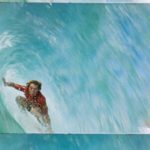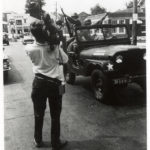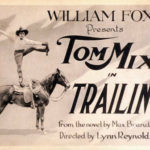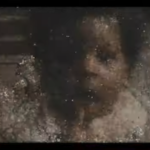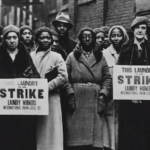Preserving the Colors of Yellowstone
First-of-its-kind film of the Park will survive thanks to a grant from the National Film Preservation Foundation
n
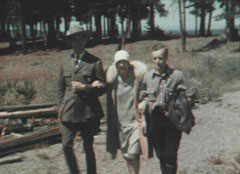 For millions of years, the region that is now the conjunction of Oklahoma, Montana, and Wyoming breathed in natural cycles until, a mere 640,000 years ago, a gigantic volcanic convulsion shaped the vast caldera of canyons and gasping geothermal floes that lies among ranges there.
For millions of years, the region that is now the conjunction of Oklahoma, Montana, and Wyoming breathed in natural cycles until, a mere 640,000 years ago, a gigantic volcanic convulsion shaped the vast caldera of canyons and gasping geothermal floes that lies among ranges there.
In comparison, the region’s human history is puny. For a mere 11 millennia, until the beginning of the 19th century, only members of indigenous tribes walked there, beginning with Paleo-Indians of the Clovis peoples. French trappers made their way to the area at the end of the 18th century and fashioned the name “Roche Jaune,” from a term, Mi tsi a-da-zi (Rock Yellow River), that the local Minnetaree tribe used, perhaps in reference to yellow rocks seen in what is now the Grand Canyon of the Yellowstone.
After American purchase of the Louisiana Purchase from France in April 1803, explorers traversed the terrain, or in the case of Captain Meriwether Lewis and his buddy, Second Lieutenant William Clark, skirted it. Trappers and traders in fur increased in number, and in 1806, John Colter, a member of the Lewis and Clark Expedition, joined one party of them and then pressed on alone late in 1807 into what is now Yellowstone National Park. He recorded geothermal activity in a place that became known as “Colter’s Hell” and almost succumbed to wounds suffered in battles with Crow and Blackfoot warriors in 1809.
For four decades, mountain men and hunters emerged from the region to tell of Infernal brimstone, boiling mud, and gushing steam vents, but were generally considered to be speaking from whisky bottles. But concerted, organized exploration increased over those years, hastening from the late 1860s to the point that in 1872, then-President Ulysses S. Grant could find them sufficiently credible that he signed legislation establishing Yellowstone National Park, the first of the nation’s now-many such preserves, in the Territories of Montana and Wyoming. The bill he signed spoke of withdrawing from settlement, occupancy, or sale land that would be “set apart as a public park or pleasuring ground for the benefit and enjoyment of the people.”
With that, the sprawling wilderness paradoxically became a declared, bounded, and tended “wilderness.” National Park designation was still sufficiently novel a concept that protection of the land was entrusted to the U.S. Army, and that arrangement persisted until 1917, when the soldiers withdrew and passed oversight and control over to the newly created National Park Service.
It had become evident that capturing wilderness in black-and-white images could do it justice. The photographs that Ansel Adams had been making in Yosemite National Park in California demonstrated as much, and he later would make extraordinary images in Yellowstone. Film-makers had visited the latter, too, but sometime shortly after 1928, a new kind of moving image would be created there with the advent of color film.
Within two or three years, color film was made in Yellowstone, but officials of the Park would not discover that until the winter of 2012/2013. It wasthen that archivists at the National Archive and Records Administration in College Park, Maryland, to the close north of Washington, D.C., made a startling discovery. It happened while they were sorting through a large shipment of records that had come to the National Archive from the National Park Service in Harper’s Ferry, West Virginia. The collection was organized by national park, and given that Yellowstone is one of the most popular national parks, its records were among the first in the horde to be inspected. And, says Criss Kovac, the supervisor of the Motion Picture Preservation Lab at the National Archives and Records Administration, “as we were going through our accessioning inspection process we came across a reel.
“We were quite excited to find it.”
She describes the discovery in a blog post:
“As we were going through our accessioning inspection process we came across a reel that appeared to be black and white, but the words on the edge said, ‘KODACOLOR.’ Other edge markings told us that the film was shot in 1930. With that bit of information, we realized that this reel could be among the earliest color films of Yellowstone National Park.”
It turned out that she and her colleagues had indeed found the first 16mm color footage taken at Yellowstone National Park, and possibly the earliest color motion picture footage of any kind shot there. They set about trying to pin down when the film was shot.
Archivists and lab technicians conducted web searches regarding particular scenes in the film hoping that a cake seen in the footage that welcomed a “Senator Rule” might provide clues to the exact date of the filming, but it did not.
They now have a 453-feet reel of unedited 16mm film that is, given its age and base type, in very good condition with little shrinkage. They have labeled it “The Yellowstone Kodacolor.” Their copy appears to be the only surviving one, and as “original reversal” is certainly the earliest. It depicts various scenes around the Park including its Old Faithful Inn which builders fashioned from lodgepole pine and rhyolite stone over the winter of 1903-04 and which remains an architectural monument of the American National Park system and approach to preservation of the country’s natural inheritance. It holds scenes of popular Park attractions: geysers and mud pots, Inn, staff, vacationers, wildlife, gardens, and other features of likely interest to anyone intent on studying the history and ecology of the Park.
The National Archives and Records Administration applied for a NFPF grant to make a new, preservation print of the film because while the agency has a fully functional film-preservation lab, it lacks the capacity for requirements of in-house work on Kodacolor. “Because Kodacolor is so rare and requires specialized technology to access the color hidden in the film, there isn’t a huge preservation market for the obsolete format,” Kovac explains in her blog post. In response to inquiries about which labs could best handle the job, Kovac and her colleagues decided to work with Video & Film Solutions after its founder, Tommy Aschenbach, demonstrated a novel computerized method of preserving the film’s content.
To understand the method, it is necessary to know how Kodacolor film works, says Kovac. Kodak introduced it in 1928 as an early reversal color home movie format and phased it out in 1935 with the advent of Kodachrome stock. To the naked eye, as she notes in her blog post, it appeared black and white, but its base side was embossed with trillions of prisms that capture the color information from the scene while it was filmed through a rotating color filter. The filter, which had three colored stripes (RGB) was placed in front of the lens and when an exposure was made a spectrum of each color passed through the filter and was recorded on the film. The color reemerged when the film was projected back through a rotating color filter.
Kodachrome replaced Kodacolor because it could be duplicated, did not require extra filters, and did not have vertical lines (the lenticules) running through the image, Kovak explains.
Aschenbach has developed a software program that can electronically decode the color information contained in the lenticular prisms affixed to the base side of the film.
NARA technicians scanned the film in what is called 2K resolution, and late in 2013 gave it to Aschenbach at Video & Film Solutions who will decode the color information, along the way testing and improving his software, which he calls “virtual encoding and decoding optical filter using the original Kodacolor patent documents.”
So, the decoded images had become visible, but to ensure that they would optimally save the color information captured in the film, they knew they would need to print it back onto film — their grant request to the National Film Preservation Foundation asked for funds to make a film copy generated directly from the decoded color file.
NARA will use its NFPF grant to have new film prints made from the 2K file that Aschenbach creates. Kovac writes: “We had our first glimpse of the images from the software when Tommy presented at The Reel Thing Symposium at the annual AMIA conference in Richmond in November of 2013.”
They will be able to observe how prints made with the digital process compare with past Kodacolor projects that used traditional photochemical preservation processes. And so will anyone who cares to view it online, with links to explanatory essays, at NARA’s website, on its YouTube channel, or on DVD.
While waiting for NPFP’s decision about their proposal, Kovac and her NARA colleagues set about deducing who might have shot the film and the identities of people in it. They reasoned that it presumably was a photography buff, because Kodacolor was rare, expensive, and required specialized cameras. Various clues led them to conclude the film likely was made by Jack E. Haynes, the park’s official photographer.
What clues? One was that a person featured in the film was Iowa state senator Arthur L. Rule who visited Yellowstone 10 times and gave lectures about the park during the winter. The archivists searched records of his movements and visits to the park, and conclude that their footage was shot during Rule’s 1930 visit to Yellowstone.
The critical piece of evidence was that, in the film, his name is seen embossed on a welcome cake presented to him.
Previous Post: Federal Funds Will Save 65 Films from Deterioration

